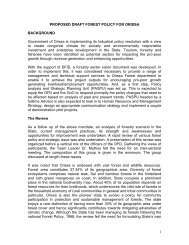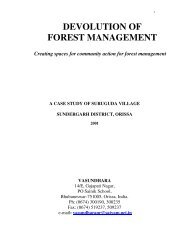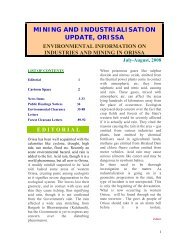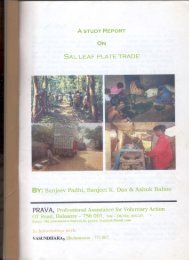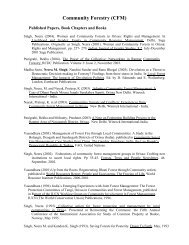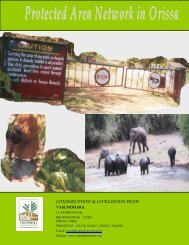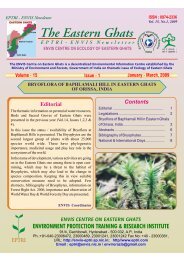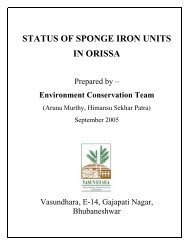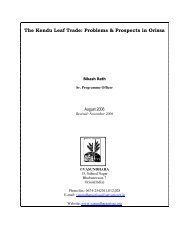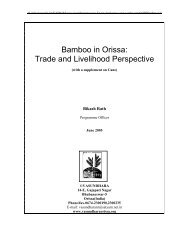Bamboo Forest Protected by Paiksahi: Rights of ... - Vasundhara
Bamboo Forest Protected by Paiksahi: Rights of ... - Vasundhara
Bamboo Forest Protected by Paiksahi: Rights of ... - Vasundhara
You also want an ePaper? Increase the reach of your titles
YUMPU automatically turns print PDFs into web optimized ePapers that Google loves.
<strong>Bamboo</strong> <strong>Forest</strong> <strong>Protected</strong> <strong>by</strong> <strong>Paiksahi</strong>:<strong>Rights</strong> <strong>of</strong> villagers under Joint <strong>Forest</strong> Management?A recent conflict over forests has brought to forth the fallacy behind the much touted Joint<strong>Forest</strong> Management Programme <strong>of</strong> the State. For villagers <strong>of</strong> <strong>Paiksahi</strong> it is a virtual shock.<strong>Paiksahi</strong> is a small tribal village <strong>of</strong> 75 households, in Tangi block in Khurda District around12 kms from Tangi. The village has been protecting around 800 hectares <strong>of</strong> Patia Reserved<strong>Forest</strong> from 1990. The FD has formed a VSS in the village (under Joint <strong>Forest</strong> Managementarrangement) and allotted them 800 hectares <strong>of</strong> Patia R.F. area for protection.This forest area which had become completely degraded now has a good bambooregeneration thanks to the efforts <strong>of</strong> <strong>Paiksahi</strong> and Kantasiri people. These people now findBILT (Ballarpur Industries Limited) on their doorsteps to harvest bamboo from their forestsand take it away for paper production. The Range <strong>Forest</strong> Officer tells these villagers that thisarea comes under <strong>Bamboo</strong> Working Circle and has been given to BILT for bambooharvesting and villagers have no right over bamboo which is a poor man’s timber and whichwe have nourished through our own sweat and life-blood… Another leader from the villagesays why don’t they just tell us that we committed a mistake <strong>by</strong> protecting this forest.Another youth says, they tell us we should just let BILT take this produce, it will preparepaper from this…. Why does the Department do this “tamasha’ <strong>of</strong> “Joth Jungle Parichalana”(Joint <strong>Forest</strong> Management) if they have to just take unilateral decisions and do ask they wishwithout any consideration to local people.Kabir, suffering from Malaria, told the local reporters, that we were told that under JFM youwould have rights over forests, forests would be managed jointly, Is this joint Management?We find that on one fine day the Company people are here to take away our forests. Wewould not let this happen. The forest is ours the company cannot take it away. We know theresolution for JFM says 50% from any major harvest shall go to VSS. The Range Officerknow says not even 1% would be shared with villagers. The Range Officer says let theharvesting take place and BILT take away the produce. The Range Officers says that in thenext Working Plan, they can make changes to ensure rights to local villagers. Kabir pleadshow can we let this happen.
The women in the village and also the near<strong>by</strong> village <strong>of</strong> Godasahi are aghast. They says wewould not let them take bamboo. We have protected forest as our child, they cannot snatch itaway from us. But after a moment, shadows <strong>of</strong> doubt cloud their faces, and they say wistfullybut what can be do, if “Sarkar” does this to us…. Please help us they appeal to outsiders whocome to their village.The neighbouring villages are joining in with <strong>Paiksahi</strong> in protest against the proposedbamboo harvesting <strong>by</strong> BILT. The leaders in Gadasahi a neighbouring village say that nextyear it would be our turn. If this happens in this case, it would happen in other cases as well.The neighbouring villages are joining in for a Joint-rally from <strong>Paiksahi</strong> to Tangi Range Officeto protest against this on 9 th November 1997.In Orissa, many villages like <strong>Paiksahi</strong> have been protecting forests. In several cases, villageshave been protecting forest from as early as 1930s. Majority <strong>of</strong> the <strong>Forest</strong> Protection effortsare more recent, starting from late 1970s and early 80s. Even the Government order <strong>of</strong> GOOfor JFM acknowledges the presence <strong>of</strong> these initiatives. These community forestry initiativesare largely self-initiated prompted <strong>by</strong> concern for dwindling forest resource and resultingscarcity <strong>of</strong> forest products. These initiatives <strong>by</strong> villagers underline the strong dependence andlinkage between forests and local communities and also point towards the feasibility <strong>of</strong>community based forest management systems. According to a study <strong>by</strong> the Social <strong>Forest</strong>ryProject (1995), 2615 villages in Orissa are protecting over 300,000 hectares <strong>of</strong> forests.According to Maa Maninag Jungle Surakhya Parishad, a federation <strong>of</strong> forest protectingvillages in the neighbouring Ranpur block, at least 6000 villages are protecting over 500,000hectares <strong>of</strong> forest.The Government <strong>of</strong> Orissa has made several efforts to ensure involvement <strong>of</strong> localcommunities in management <strong>of</strong> forests. Government <strong>of</strong> Orissa happens to be the first State toissue a resolution to involve local people for protection <strong>of</strong> forests in August 1988. Thisresolution was a precursor to what has gained prominence as the Joint <strong>Forest</strong> Managementapproach all over India. The Government <strong>of</strong> Orissa issued a more detailed resolution in 1993adopting Joint <strong>Forest</strong> Management Approach. Under Joint <strong>Forest</strong> Management, the <strong>Forest</strong>Department and local villagers are to be partners in the task <strong>of</strong> protection and management <strong>of</strong>forests. Under this arrangement, Van Samrakshan Samiti (VSS) has to be formed and the
VSS has to be given specify responsibility over protection and management <strong>of</strong> a wellspecifiedforest area to be allotted to VSS for the purpose.Under JFM, all intermediate yield in shape <strong>of</strong> small wood, poles, fire wood etc. as may beobtained in silvicultural operations will be equitably distributed among the members (<strong>of</strong>VSS) <strong>by</strong> the executive committee (<strong>of</strong> VSS). Timber and poles as may be obtained from amajor harvest or final felling shall be shared between the <strong>Forest</strong> Department and the VanaSamrakshan Samiti in equal shares. The executive committee on behalf <strong>of</strong> the Samiti willhave the option either to distribute the said 50 percent <strong>of</strong> the total produce among themembers <strong>of</strong> the Samiti in equal shares or to request the <strong>Forest</strong> Department to dispose <strong>of</strong> thesame and make the net sale-proceeds available for distribution in cash among the members.Thus, 100% <strong>of</strong> the intermediate produce and 50% share in any major harvest from the forestarea allotted to the VSS is the rightful share <strong>of</strong> VSS under JFM.What happens in this tribal village <strong>Paiksahi</strong> is going to determine the fate <strong>of</strong> FP efforts in theentire area. According to Maa Maninag Jungle Surakhya Parisad, the Tangi and Ranpurblocks around 150 villages are involved in forest protection and most <strong>of</strong> these forests havebamboo as the main crop. The other surrounding villages are going to cut down the forestwithin days if they see this as the outcome <strong>of</strong> years <strong>of</strong> voluntary patrolling <strong>by</strong> thengapalli.Villages in Orissa which have on their own protected forests believe that forest is theirs butare now in for a shock with such cases coming up. In the initial years when the forests werein early stages <strong>of</strong> regeneration there were no conflicts, because there was virtually notingavailable from forests. But now with forests reaching harvestable stage, the issue <strong>of</strong> whoseforests and rights <strong>of</strong> local people have come up. In this particular case a VSS has been formedwhereas there are numerous cases where villagers have been protecting forests but the FD hasnot recognized these efforts and has not formed VSS. What is going to happen to the rights <strong>of</strong>villagers in such cases. Are villagers to be blamed or need they suffer due to theadministrative bottle-necks and reluctance to formation <strong>of</strong> VSS. The <strong>Forest</strong> Department tillnow has formed only 1100 VSS while there are over 6000 villages involved in forestprotection. How would the rights <strong>of</strong> these villages whose informal <strong>Forest</strong> ProtectionCommittee not recognized <strong>by</strong> the FD get protected when similar situations come knocking attheir doors?



